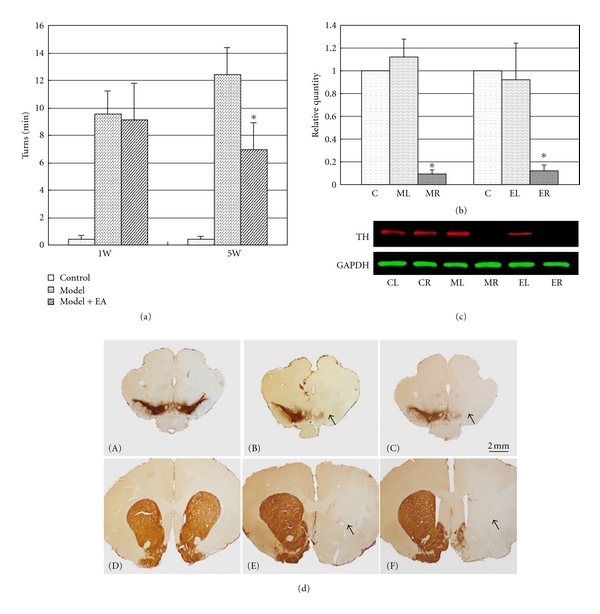Figure 1.

PD rat models were prepared using 6-OHDA and were treated with 100 Hz EA. EA at 100 Hz was applied at the acupuncture points DAZHUI (GV14) and BAIHUI (GV21) for 28 days. Rotational behavior induced by apomorphine was measured 1, 2, and 5 weeks after 6-OHDA treatment of the MFB. (a) The Y-axis represents the net number of turns of rats per minute. The X-axis represents the detection time. The net number of turns per minute of the 5-week EA-treated group decreased significantly compared to the corresponding 5-week model group (P < 0.001). ((b) and (c)) Western blotting results revealed that the expression of TH was significantly downregulated in the right STR of the 6-OHDA-treated rats (MR) and the EA-treated model rats (ER) compared to the nonlesioned side (c). CL and CR represent the left and right STR of the control rats, respectively. The relative grey level is presented in (b) (*P < 0.01). The Y-axis represents the relative grey value versus the control. The X-axis represents different groups. In addition, the extensive loss of DA neurons in the rat SN and STR was detected using Tyrosine hydroxylase- (TH-) specific immunostaining (scale bar 2 mm, (d)-(A)–(d)-(F)). As indicated by the arrows in (d), representative microphotographs of the right STR ((d)-(E) and (d)-(F)) and SN ((d)-(B) and (d)-(C)) after TH immunostaining showed an extensive reduction in the density of TH-immunoreactive axons in the STR and SN of 6-OHDA-treated rats, regardless of EA treatment (right STR of (d)-(E) and (d)-(F) and right SN of (d)-(B) and (d)-(C)), compared to the control ((d)-(A) and (d)-(D) or the left of model STR or SN).
